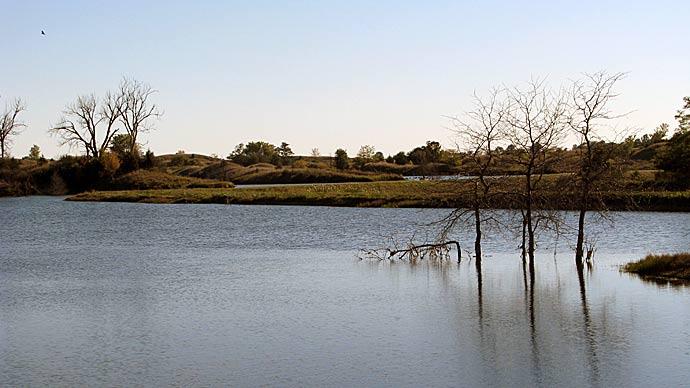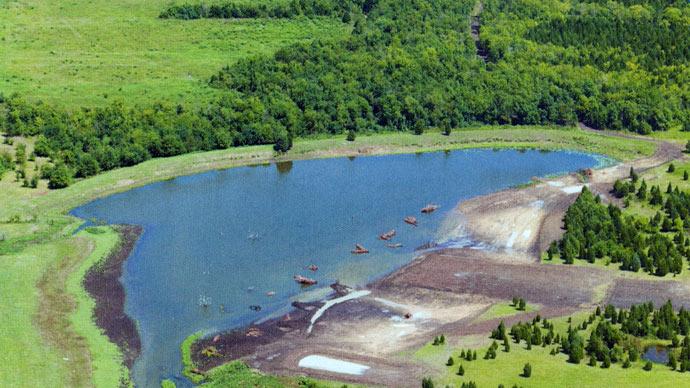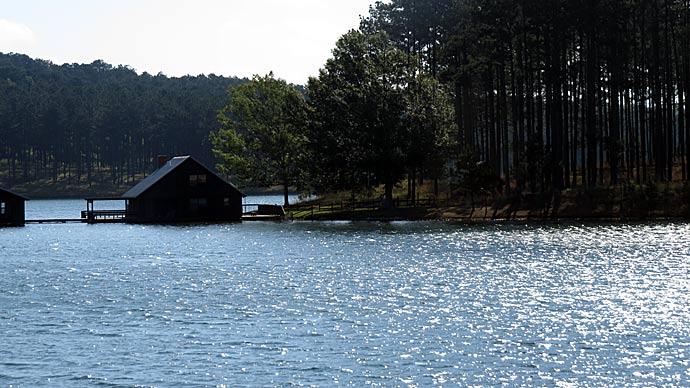
It doesn't seem that long ago that ponds were pushed up with a bulldozer out in a field so livestock could have water to drink.
That still happens.
Next time you drive through a subdivision neighborhood where you live, see if there's a pond surrounded by houses. Give it a good look. Odds are, that pond was built decades ago in a pasture for cattle to drink. Later, developers came, divided the land, built roads, added utilities, and left the pond there. A cattle pond became an urban water feature. After all, water attracts people. I see those circumstances often all over the United States.
Sure, there were other reasons people built ponds way back when. Irrigation was a big one in rural areas. Still is. The well could only produce so many gallons per minute, so ponds were built so bigger pumps could push more water onto crops faster. In urban areas such as Houston, the city required a water source next to a big building in case of fire.
It wasn't pretty much until the 1980s when reasons for ponds began to change. Many people grew up on farms in the '40s, '50s, and '60s. Many went to college, got their degrees, moved to the city, got jobs, raised families, and by the 80s, quite a few had this thing called "disposable income."
Quite a few got jobs, kept the family farm, and did what they could to earn a living from both gigs. In Whitesboro, Texas, where I lived for almost four decades, a local banker worked at the bank from 9:00- 3:00, Monday through Friday, and worked his farm all hours of the rest of each day and on weekends. Two local teachers did the same, as did our city's attorney.

As people aged out from their small farms, baby boomers began buying these small par¬cels of land and turning them into weekend retreats. As that happened, land use changed, as did the purposes of building a pond.
Today, when a landowner calls or emails, the first thing I ask is, "What are your goals?"
Often, people don't really think all the way through that question. Often, the response is, "We just bought this property and planned to build a house on it. We'd like a pond, too."
In today's world, there are many reasons to build a pond. Sure, farmers and ranchers still want to provide water for livestock. Gentlemen ranchers with weekend homes may also want a pond nearby for esthetics.
By far today, people want fishing ponds. Some want their grandkids to catch fish off the dock, while others want to raise the biggest fish on the planet.
There are other purposes as well. Heck, where we lived for 20 years, we had eight ponds scattered over 11 acres. Each pond had its unique purpose. Beside the house was our Swimming Pond, designed by Debbie for grandkids to enjoy. We had a dock and zipline, and I even built a shelf four feet deep along the shore next to a rock patio for safety. We let the far side of the pond grow wild and natural. The upper third of the pond ended up with fish structure, while most of the pond was barren, like a swimming pond. Many kids swam there and caught their first fish. Debbie loved getting a bottle of wine, chilling it, then wrapping a float around her waist on a steamy-hot July day and float, sipping her favorite white. I must admit, that was really fun.
We had a pond designated for catfish and sunfish. That pond was to grow food for the table and for kids to catch their first fish...or second, or third, or a stringer full.

We had an experimental pond where we tested fish food for Purina Mills. That pond ended up with nearly forty beautiful Japanese koi, which often showed their colors, especially during spawn each spring. That pond also has lots of bluegills, some bass, and a handful of hybrid stripers.
We had two one-tenth-acre hatchery ponds. Another tiny pond sat below a bluff. It was a reflecting pond.
People want ponds to train hunting dogs, attract waterfowl, enhance wildlife, and supply water for their lawns, flower beds, and gardens. People love water features with waterfalls and artificial streams. They want fountains to see and hear and circulators to create currents. People love attracting song¬birds and watching a doe bring her fawn to the pond late in the afternoon for a drink.
Debbie loved having coffee on the back porch each morning when the weather was good, watching the pond to see what was happening that day. It might be the shrill call of a wood duck as it entered one of our nesting boxes. It might be a woodpecker hammering a standing dead tree across from the house. We'd see a flock of turkeys wander by on a few occasions. Often, a bass would blow up on baitfish near the shore next to the house.

In those old days, if you wanted a pond, you'd go to the local small-town coffee shop by 5:30 in the morning and look for the grizzled, older guy with a khaki shirt and bib overalls. That was the bulldozer guy. You'd better get there early because he'd finish his third cup, maybe some breakfast, and be on-site, servicing his dozer and warming it up so he could get to work at first light.
It's not quite like that now. Laser levels on heavy equipment, great topo maps online, sophisticated technology, and engineering take some guesswork out of building a pond. But what remains true is that lots of earthmovers still think they will show up, move some dirt around, and you'll have a pond.
It's a learning curve still freshly being moved from people's ideas onto the canvas of the earth, your property.
Nowadays, planning a pond based on its purpose is most common.
And those purposes are often as unique as the pond site and the person who owns it.
Reprinted with permission from Pond Boss Magazine



